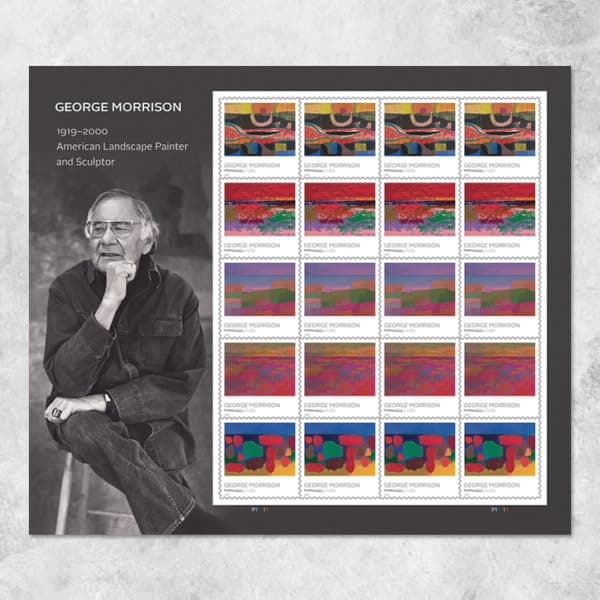Praveen Fernandes | September 23, 2022
The Salutations and Valedictions Edition
On conventions, niceties, and correspondence
Recommended Products
A Hulu series marked by intergenerational humor, featuring Martin Short, Steve Martin, and Selena Gomez.

A collection of postage stamps celebrating the painter George Morrison, a leading Native American modernist artist.

Postage stamps celebrating the James Webb telescope, the most sensitive telescope ever deployed in space.

A tribute to Japanese American servicemembers of WWII through a collection of postage stamps.
Praveen Fernandes (PF) is my brother-in-law and a previous WITI contributor (the very excellent Owl, Stamps, and Federal Architecture Editions). His bio is far longer than I could list here, but briefly, he’s a lawyer, advocate, former Obama administration appointee, and art lover. - Noah (NRB)
Praveen here. Hulu’s “Only Murders in the Building” is marked by intergenerational humor. In a scene from the first season, after deciding that young people prefer texts to calls, the two older protagonists (played by Martin Short and Steve Martin) are deciding how to sign off texts to the younger protagonist (played by Selena Gomez). The humor lies in the fact that text messages aren’t generally signed. As an audience member, I laughed. But truth be told, I remember when texting was a new technology, and I remember signing my early texts. Perhaps I even remember being mocked by my more tech-savvy friends. (Let us not speak of this again.)
New technologies beget new conventions. But not immediately. There exists a lag period between the emergence of a correspondence technology and the development of correspondence conventions that better suit the new form. I remember joining a law firm in the late 1990s, newly graduated from law school, when email was a somewhat new way of communicating with clients. The old method involved printed legal memoranda on heavy firm stationery, with handwritten signatures or initials accompanying the authors’ names at the top; these memoranda were mailed to clients or couriered to clients who were within the city. During the transition to electronic communication, I remember style manuals containing suggestions of how to begin and end email messages to clients, with “Sincerely,” “Best regards,” or “Warm regards” being common ending options.
Why is this interesting?
Email messages increasingly drop such niceties (or default to incorporating them into an electronic signature). That’s unsurprising. New technology now allows us to know the sender and the recipient immediately, arguably eliminating the need for such things. But it’s not simply a matter of technology. The opening line (“Dear ___,”) of a traditional letter is referred to as a salutation, and the closing (“Sincerely, ____”) is referred to as a valediction. These lines did more than merely announce to whom the letter was intended and from whom it was being sent. After all, akin to email messages, there was an address and a return address on the envelope of an old-fashioned letter, so the “to” and “from” were hardly mysteries. Salutations and valedictions also provided an emotional context and information about how people knew each other. For archivists, a letter beginning with “My darling Reshma,” and ending with “Your doting brother, Rajesh,” conveys a lot. And social norms came into play. For instance, in the early 1900s, it would have been inappropriate for a man to use the valediction “Love,” to a woman to whom he was not related or to whom he was not engaged to be married.
Some valedictions seem unusable now. For instance, Thomas Jefferson’s “Your most obedient and most humble servant,” is unlikely to be adopted by today’s government officials. And modern valedictions might have derivations that surprise those who casually use them today. For instance, some argue that “Yours truly” and “Sincerely yours” actually began as abbreviations for “Your servant truly” and “Sincerely your servant,” with the lowercase “s” in each instance appearing as a superscript.
There is likely no shortage of advice for salutations and valedictions on the internet, such as those for business correspondence, those for email messages, and those for email messages in particular industries. And there are seasonal valedictions, like the “Happy holidays!” valediction that pops up in work email as a customary closing around December each year. However, I’m intrigued by the ones that seem to emerge organically, instigated by new circumstances. For example, in the spring of 2020, when the coronavirus pandemic placed large parts of the world in lockdown, I noticed that many email messages I received were capped by “Stay safe,” or “Hoping you are and remain safe,” endings that would have been odd and meaningless in the spring of 2019. A valediction was forged by a collective threat that was very specific to 2020. And it told the recipient something non-generic; it certainly wasn’t part of anyone’s electronic signature. For future readers of such correspondence, it conveys something about how we interacted with each other, what concerned us, and what was going on at the time. And that’s before one gets to the actual substance of the correspondence.
Of course, writers like Matthew J.X. Malady, have made a strong (and droll) case for eliminating sign-offs entirely in email. He argues that any awkwardness at first will be offset by the time saved, and ultimately, will become less awkward. But I can’t help but feel that part of his quarrel with email valedictions stems from their being generic and poorly chosen. As he explained:
But everyone has a breaking point. For me, it was the ridiculous variations on “Regards” that I received over the past holiday season. My transition from signoff submissive to signoff subversive began when a former colleague ended an email to me with “Warmest regards.” Were these scalding hot regards superior to the ordinary “Regards” I had been receiving on a near-daily basis? Obviously they were better than the merely “Warm Regards” I got from a co-worker the following week. Then I received “Best Regards” in a solicitation email from the New Republic. Apparently when urging me to attend a panel discussion, the good people at the New Republic were regarding me in a way that simply could not be topped.
Malady’s piece was published in 2013. Roughly a decade later, it’s not even that awkward to eliminate valedictions in email messages. So, it’s understandable if people want to jettison them. But I know where I stand on the topic.
Your faithful correspondent I remain, P.F.
Exhibition of the Day
Until February 26, 2023, you’ll be able to see the finalists of the triennial Outwin Boochever Portrait Competition at the National Portrait Gallery in Washington, DC. The 42 winning pieces, which can also be viewed online here, were selected by expert jurors from a pool of over 2,700 entries. The finalists challenge restrictive notions of portraiture and span genres—paintings, sculptures, and photographs, but also videos and soundscapes. What does it mean to make a portrait of your mother in India comprised of surveillance camera footage capturing years of your conversations and anxious monitoring from thousands of miles away in New York, as the artist Cheryl Mukerji did? Or to capture in a video portrait and day-long performance the societally unacknowledged and underappreciated labor of Black women, as the artist Holly Bass did? You can see these works and more in this stirring exhibition.
And you never know whose career will earn a well-deserved lift from the competition. The painter Amy Sherald won the 2016 competition with her gorgeous painting “Miss Everything (Unsupressed Deliverance),” and then, helped in part by the greater attention paid to her work, went on to be chosen to paint this iconic portrait of former First Lady Michelle Obama. (PF)
Quick Links:
The United States Postal Service has a bevy of new 2022 postage stamps on offer, including one that celebrates the painter George Morrison (one of the leading Native American modernist artists) and the James Webb telescope (the most sensitive telescope ever deployed in space). Still available is last year’s tribute to Japanese American servicemembers of WWII and coming soon (next month!) will be a stamp honoring the women cryptologists of WWII. (PF)
—
WITI x McKinsey:
An ongoing partnership where we highlight interesting McKinsey research, writing, and data.
How to remove unconscious bias from the workplace. When it comes to job performance, unconscious bias can be more harmful than explicit discrimination—and everyone at work suffers for it.
Read and see why tackling this problem benefits everyone.
—
Thanks for reading,
Noah (NRB) & Colin (CJN) & Praveen (PF)
—
Why is this interesting? is a daily email from Noah Brier & Colin Nagy (and friends!) about interesting things. If you’ve enjoyed this edition, please consider forwarding it to a friend. If you’re reading it for the first time, consider subscribing (it’s free!).
